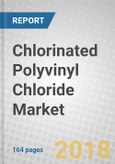Report Scope:
This report provides key market analysis, highlights market drivers and constraints, and discusses competitive developments and trends in the CPVC market. This research analyzes the CPVC market in terms of applications, regulatory environment, technology, market projections, and market shares.
This report discusses the CPVC industry and its various resources. It covers the overall CPVC market for different applications. A complete regional analysis of the market is also studied in the report. The CPVC market by region is broken down into five segments: North America, Europe, China, Asia and the rest of the world (ROW).
The technological issues discussed in the report encompass the latest trends, pipeline products, and developments. Also included in this report are comprehensive profiles of companies that are leaders in the CPVC market. The key market players are Lubrizol, Sekisui Chemical, Kaneka, and Kem One (Arkema) along with several others.
The Report includes:
- 77 data tables
- An overview of the global markets for Chlorinated Polyvinyl Chloride (CPVC)
- Analyses of global market trends with data from 2017, 2018, and projections of compound annual growth rates (CAGRs) through 2023
- Coverage of important manufacturers, technologies, and factors influencing demand
- A look at the regulatory and environmental developments, along with advances in the CPVC manufacturing and applications
- Examination of the CPVC industry structure, market saturation, and demographic changes
- Comprehensive company profiles of major players in the Market including Asahi Yukizai, Astral Poly Technik Ltd., Charlotte Pipe and Foundry Co., Cresline Plastic Pipe Co. Inc., Epsco International Inc., Kaneka, Lesso, Simona AG, and The Lubrizol Corp.
Table of Contents
Samples

LOADING...
Executive Summary
Chlorinated polyvinyl chloride (CPVC), also called post-chlorinated PVC, is a thermoplastic produced by the modification of polyvinyl chloride (PVC) resin. The modification process is called (chlorination).
CPVC is significantly more flexible and can withstand higher temperatures and more severe corrosion than standard PVC. CPVC is especially good for use with halogenated solvents, acids, and other materials.
It also is stronger than PVC and is the choice for hot corrosive liquids, hot- and cold water plumbing pipe and similar applications.
CPVC resins are mixed with additives and other materials to make CPVC compounds. Today, most of the major CPVC resin producers are also CPVC compounders. The compounding process increases both the volumes and values of CPVC.
CPVC compounds are used for making CPVC products such as pipe and tubing (P/T) and fittings through processing CPVC compounds by injection or blow molding, thermoforming, extruding, or other methods. The processing increases the market values but slightly reduces the volumes due to the material loss in the processing steps.
In this report, we include both pipe and tubing for completeness of the pipe industry. A pipe is defined in the McGraw-Hill “Dictionary of Scientific and Technical Terms” (4th Edition) as “a tube made of metal, clay, plastic, wood or concrete and used to conduct a fluid, gas or finely divided solid.” Note that this definition uses the term “tube” to define a pipe; this is in keeping with the definition of the tube from the same dictionary as “a long cylindrical body with a hollow center, used to convey fluid.” Thus, “tube” is the overriding word used to denote any long hollow cylinder. In the pipe and tubing industry, the terms usually are used in different contexts. All pipe is tubing, but all tubing is not a pipe. The standard industry definition and understanding is that pipe usually is larger, and for years has been defined by the dimensions of the standard iron pipe. Tubing usually is smaller in diameter and generally made to closer tolerances than the pipe, with different dimensional standards. Often, the tubing has a finer and smoother finish than the pipe and is used in more exacting applications, such as transport of fine chemicals and pharmaceuticals.
In addition to P/T and fittings, CPVC is also used in other applications such as coatings, adhesives, plastic modifiers, and industrial plates. These other products together account for only a little over 10% of the total of the CPVC product market.
Companies Mentioned
- Adelant
- Ajay Industrial Corp. Ltd.
- Aplaco
- Asahi Yukizai
- Ashirvad Pipes Pvt. Ltd.
- Astral Pipes Ltd.
- Astral Poly Technik Ltd.
- Asung Plastic Co. Ltd.
- Cepex
- Charlotte Pipe And Foundry Co.
- China Youli Piping Co. Ltd.
- Cresline Plastic Pipe Co. Inc.
- DCW Ltd.
- Durman
- Epsco International Inc.
- Era/Yonggao Co. Ltd.
- Finolex Industries Ltd.
- First Plastics
- Formatura Iniezione Polimeri
- Futura Industrial
- Genova Products Inc.
- Georg Fischer
- Hangjin Technology Co. Ltd.
- Hangzhou Electrochemical Group Co. Ltd.
- Hanwha
- Harrison Machine & Plastic Corp.
- Inner Mongolia Chenhongli Chemical Co. Ltd.
- Ipex
- Jiangsu Tianteng Chemical Industry Co. Ltd.
- Kaneka
- Kem One
- Kem One Chemplast
- Kubota Chemix
- Lesso
- Marvel Technoplast
- Meghmani Organics
- National Marketing Est. Co. Ltd.
- Nibco
- Oatey
- Paradise Industry
- Phoenix Industries Ltd.
- Rauschert
- S And L Specialty Polymers Co., Ltd. (S&L)
- Sekisui Chemical
- Shandong Gaoxin Chemical Co. Ltd.
- Shandong Xiangsheng New Materials Technology Co. Ltd.
- Shandong Xuye New Materials Co. Ltd.
- Shanghai Chlor-Alkali Chemical Co Ltd.
- Simona Ag
- Supreme
- The Lubrizol Corp.
- Tianjin Hongtai Pipe Industry Co. Ltd.
- Weld-On Adhesives Inc.








